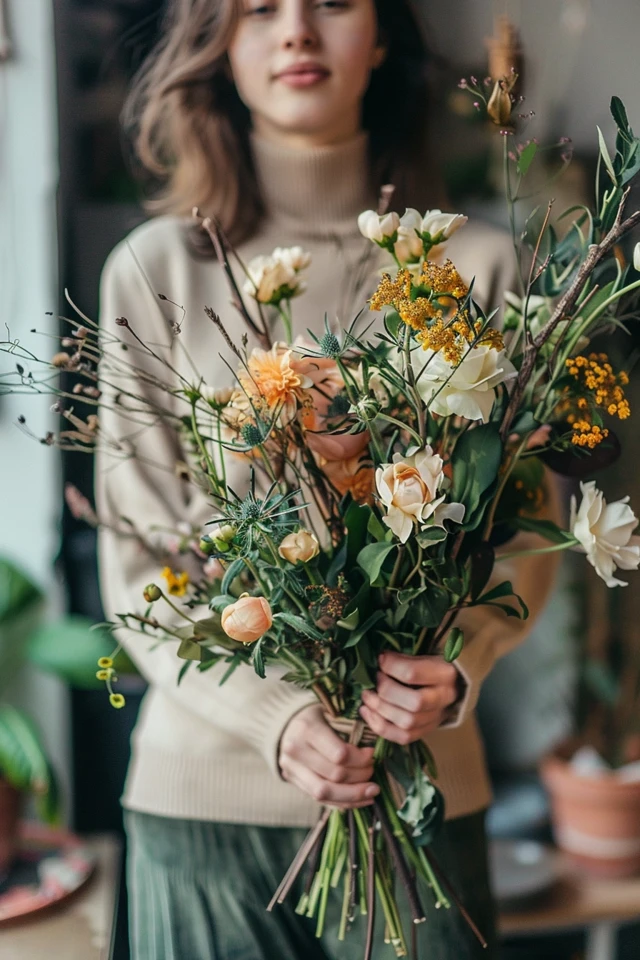Preserving flowers is an art that allows us to capture their natural beauty and extend their lifespan. Whether you want to cherish a special bouquet or create stunning dried flower arrangements, knowing the right techniques is essential. In this flower processing guide, I will share various methods for preserving flowers that will help you maintain their freshness for an extended period. Let’s dive in!
Key Takeaways:
- Preserving flowers allows you to enjoy their beauty for longer.
- Air drying, pressing, using a microwave, and drying in the oven are popular methods for flower preservation.
- Air drying is ideal for sturdy blooms, while pressing is suitable for delicate and flat flowers.
- A microwave can be used for quick drying, and an oven is great for creating potpourri.
- Coating dried flowers with unscented hairspray can provide extra protection.

Air Drying Flowers
Air drying is one of the most popular methods for preserving flowers. It’s simple, effective, and doesn’t require any special equipment. Here are some tips for air drying your flowers:
- Start by selecting flowers that are in their prime, just before they fully open. Sturdy blooms work best for air drying.
- Remove any excess foliage from the stems, as they can retain moisture and cause the flowers to mold.
- Trim the stems to about 6 inches long, allowing for easier handling and hanging.
- Cluster a small group of flowers together and tie them with twine or string. Make sure they are not too close to each other to allow proper airflow.
- Find a well-ventilated and dry location to hang the flowers. Avoid areas with high humidity or direct sunlight, as they can cause the flowers to fade or wilt.
- Let the flowers hang undisturbed for about two to three weeks. The drying time may vary depending on the flower type and humidity levels.
- Check the flowers regularly to ensure they are drying properly and aren’t developing any mold or rot.
Once the flowers are fully dried, you can protect them further by applying a light coat of unscented hairspray. The hairspray acts as a sealant, helping to preserve the color and shape of the flowers.
Air drying is a simple and cost-effective way to preserve flowers and extend their beauty. With these tips, you’ll be able to enjoy your dried flowers for months to come.

Pressing Flowers
When it comes to preserving delicate and flat flowers, pressing is an ideal technique. It allows you to retain the shape of the flowers while extending their lifespan. Follow these simple steps to press your flowers:
- Start by removing any unwanted leaves from the stem of the flowers. This will ensure that only the petals are preserved.
- Next, cut the flowers to the desired length. This will make it easier to arrange them when pressing.
- Prepare the flowers for pressing by placing them between two sheets of wax paper or parchment paper. Make sure they are evenly spaced and do not overlap.
- Take a heavy object, such as a hardback book, and place it on top of the flowers. This will apply pressure evenly, helping to flatten and dry the flowers.
- Leave the flowers pressed for at least a week to ensure they dry thoroughly. The drying time may vary depending on the type of flower and its moisture content.
Pressing flowers is not only a way to preserve their beauty but also a way to create unique pressed flower artworks or crafts. You can use pressed flowers to decorate greeting cards, create bookmarks, or even frame them to hang on your wall as a beautiful reminder of nature’s beauty.
“Pressing flowers allows you to capture their delicate beauty and prolong their lifespan in a visually appealing way.”
By utilizing flower preservation techniques like pressing, you can keep your favorite flowers fresh for a longer period. This method is particularly useful for delicate flowers that would otherwise wilt quickly. So start pressing your flowers and unlock the creative possibilities they hold!

Using a Microwave or Oven to Dry Flowers
Drying flowers using a microwave or oven can be a convenient and effective method for preserving their beauty. When using the microwave method, begin by placing the flowers in a dish with a drying agent like silica gel. Heat the flowers in 30-second intervals, ensuring they feel dry to the touch. Afterward, leave the flowers in the drying agent for a whole day before removing them. Please note that using an oven may alter the flower’s color and cause the petals to drop, so it is not recommended for display purposes. However, it can be ideal for creating delightful potpourri. To do this, simply lay the petals on a cookie rack placed on a baking sheet and bake at a low temperature for approximately two hours, keeping an eye out for any signs of shriveling after one hour.
By being mindful of these flower preservation techniques, you can extend the freshness of your bouquets and ensure they stay vibrant for longer. Whether you choose to air dry, press, or utilize the microwave or oven methods, each technique has its unique advantages. So go ahead and try these tips for preserving flowers, and enjoy their beauty even after their natural lifespan has ended.

